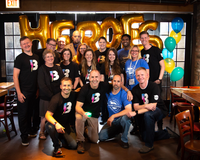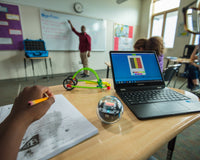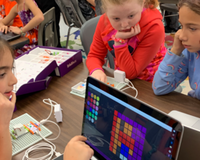Constructivism is one of many learning theories that inform how educators teach and plan their curricula. The foundational principle of constructivism is that a student’s learning is directly influenced by their prior knowledge and experiences. In other words, kids come to the classroom with their own experiences and perspectives, and everything they learn builds upon this. For educators, this means recognizing that each student’s learning process and knowledge are unique.
Under the constructivist theory, learning is also understood as an active process, in which students acquire knowledge best when they are making connections and engaged. Educators will recognize the importance of this approach in teaching STEM subjects where dynamic learning styles and interactive activities can improve the understanding of concepts and knowledge retention. In this article, we’re highlighting several STEM activities that draw from constructivist theory.
STEM Activities to Promote Constructivism
Problem Solving and Design Activities
Because constructivism proposes that knowledge is built, not simply transmitted, it’s important to integrate STEM activities that combine new concepts and information with relatable and engaging elements. Below are a few ideas to spark inspiration:
- Assign engineering challenges that are based on real-world scenarios. For example, students can build a functioning bridge from materials like straws and popsicle sticks or the Sphero Blueprint kit. Their understanding that a bridge must be strong and stable will form the foundation of the activity, as they try different shapes and structures to find the best bridge design. From there, physics concepts like compression and tension will be easier to understand.
- Diving straight into programming can be an abstract concept for young learners. Ease students into it using coding puzzles, which are both accessible and interactive. There are a wide range of unplugged coding puzzles available, including cup stacking, which involves having a student write step-by-step instructions for stacking cups in a particular pattern. Another student then must build the structure using only the instructions. This activity helps students learn the steps involved in writing code so that it feels more intuitive when they use digital tools.
- Complex concepts like automation and mechanics can be best understood through hands-on activities that leverage familiar technologies and ideas. For example, students can build a robot using building blocks like Sphero’s littleBits kits. The building process, while fun, will also help them to learn how mechanics like articulation and axles function. Next, they can program the robot to move or perform a specific task so they can see automation at work firsthand.
Collaboration and Communication Activities
Encouraging collaboration in the classroom is a reliable way to ensure students are both building social skills and actively learning STEM, not just passively receiving information. Here are some ideas for STEM collaboration and communication activities that follow constructivist principles.
- Facilitate STEM debates and discussions where students can actively talk about and process their ideas together. This lets students lead the conversation and allows them to learn things by making connections as a group. For example, you can assign a math equation without teaching them the traditional method for solving it. By working together, students can figure out how to solve the equation. Then, you can show them alternative ways to solve it. Ultimately, this form of an independent, collaborative project can build confidence and empower kids to learn.
- Group projects that integrate data analysis and presentations are another effective way for students to learn constructively. Assign topics that relate to students in some way. For example, an investigation into local environmental issues will allow students to build on their existing knowledge of where they live and enhance it with data that they can synthesize and make sense of. From there, groups can present their findings, which both helps them to retain what they’ve learned and enables the rest of the class to learn about local issues.
- Hands-on group projects, like collaborative design and building competitions, encourage students to think creatively and cooperatively. A simple paper plane design challenge using recycled materials will get kids to combine their knowledge to design, build, test, and redesign a plane. This multi-step process also lets students learn through trial and error, which helps them develop their deductive reasoning and problem-solving skills. From a STEM perspective, it also teaches them intuitively about aerodynamics.
Constructivism Tips for Educators
In addition to finding the right STEM activities to integrate into a constructivist approach to learning, there are several tips that can help educators create an active and collaborative learning environment for students of all ages and abilities.
- Recognize that each student is unique and coming to the classroom with their own experiences and existing knowledge, which will guide how they understand new material.
- Ask open-ended questions to encourage inquiry and exploration among students. This is in line with the constructivist idea that students are not only acquiring knowledge but are learning how to learn.
- Encourage collaboration and communication of ideas. This is a great way to have students process information and ideas in an open forum, which can lead to a deeper understanding of material.
- In addition to creating a collaborative environment, it’s also important to promote independent thinking and student ownership. This helps students build confidence in their own reasoning and deduction abilities.
- Integrate real-world applications and make connections to relevant careers in the classroom. Since students have lives outside the classroom, it only makes sense for them to connect what they learn to the world around them. Bringing relatable applications into school can help build these bridges.
- It’s important to tailor activities to different ages and skill levels so that students can maximize “building” their knowledge. In other words, activities can progress in difficulty and complexity because students will have a greater foundation of knowledge to build on.
- Get students to discuss and reflect on what they’ve learned. This can be done as a class or in smaller groups and will enable students to solidify what they’ve learned and introduce new questions and ideas that can be addressed in upcoming lessons.
Other Learning Theories to Explore
Constructivist learning has proven to be a highly popular theory among educators, as it recognizes differences between students and takes a student-led approach to learning. However, it is not the only learning theory out there. You can learn more about educational theories, like connectivism and experiential learning, in this learning theories blog.
About the Author
The Sphero Team

The Sphero Team is comprised of current and former educators, education content and curriculum writers, product designers, engineers, executive leadership, and other experts in their fields. Learn more about who we are and what we do at sphero.com/about.










